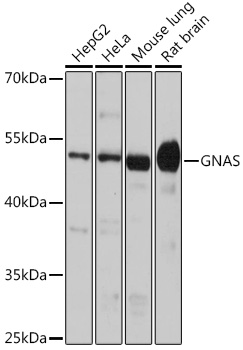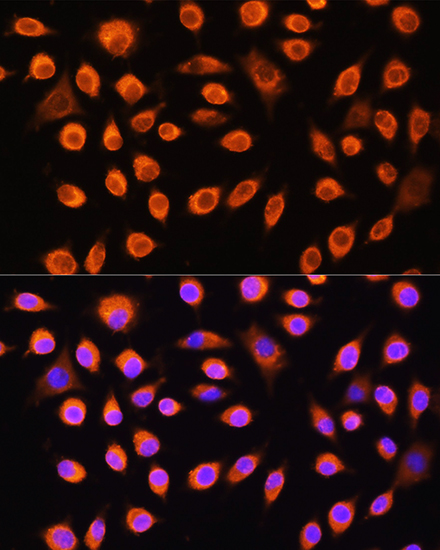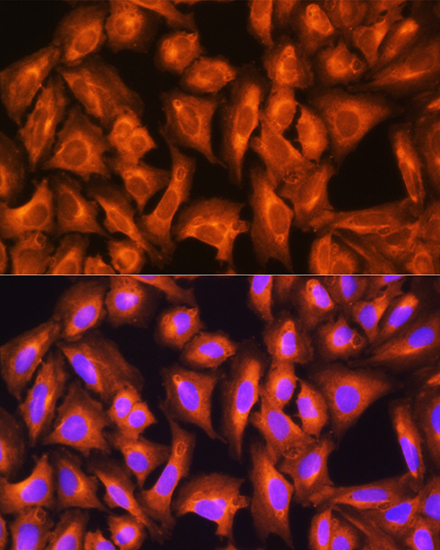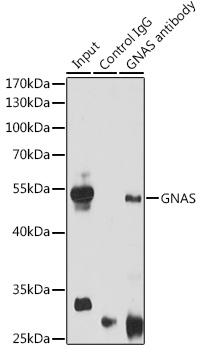Cell Biology Antibodies 9
Anti-GNAS Antibody (CAB5546)
- SKU:
- CAB5546
- Product Type:
- Antibody
- Reactivity:
- Human
- Reactivity:
- Mouse
- Reactivity:
- Rat
- Host Species:
- Rabbit
- Isotype:
- IgG
- Antibody Type:
- Polyclonal Antibody
- Research Area:
- Cell Biology
Description
| Antibody Name: | Anti-GNAS Antibody |
| Antibody SKU: | CAB5546 |
| Antibody Size: | 20uL, 50uL, 100uL |
| Application: | WB IF IP |
| Reactivity: | Human, Mouse, Rat |
| Host Species: | Rabbit |
| Immunogen: | Recombinant fusion protein containing a sequence corresponding to amino acids 1-394 of human GNAS (NP_000507.1). |
| Application: | WB IF IP |
| Recommended Dilution: | WB 1:500 - 1:2000 IF 1:50 - 1:200 IP 1:50 - 1:200 |
| Reactivity: | Human, Mouse, Rat |
| Positive Samples: | HepG2, HeLa, Mouse lung, Mouse brain, Rat brain |
| Immunogen: | Recombinant fusion protein containing a sequence corresponding to amino acids 1-394 of human GNAS (NP_000507.1). |
| Purification Method: | Affinity purification |
| Storage Buffer: | Store at -20'C. Avoid freeze / thaw cycles. Buffer: PBS with 0.02% sodium azide, 50% glycerol, pH7.3. |
| Isotype: | IgG |
| Sequence: | MGCL GNSK TEDQ RNEE KAQR EANK KIEK QLQK DKQV YRAT HRLL LLGA GESG KSTI VKQM RILH VNGF NGEG GEED PQAA RSNS DGEK ATKV QDIK NNLK EAIE TIVA AMSN LVPP VELA NPEN QFRV DYIL SVMN VPDF DFPP EFYE HAKA LWED EGVR ACYE RSNE YQLI DCAQ YFLD KIDV IKQA DYVP SDQD LLRC RVLT SGIF ETKF QVDK VNFH MFDV GGQR DERR KWIQ CFND VTAI IFVV ASSS YNMV IRED NQTN RLQE ALNL FKSI WNNR WLRT ISVI LFLN KQDL LAEK VLAG KSKI EDYF PEFA RYTT PEDA TPEP GEDP RVTR AKYF IRDE FLRI STAS GDGR HYCY PHFT CAVD TENI RRVF NDCR DIIQ RMHL RQYE LL |
| Gene ID: | 2778 |
| Uniprot: | O95467/P63092/P84996/Q5JWF2 |
| Cellular Location: | Cell membrane By similarity; Lipid-anchor By similarity |
| Calculated MW: | 28kDa/44kDa/45kDa/77kDa/109kDa/111kDa |
| Observed MW: | 50KDa |
| Synonyms: | GNAS, AHO, C20orf45, GNAS1, GPSA, GSA, GSP, NESP, POH, SCG6, SgVI |
| Background: | This locus has a highly complex imprinted expression pattern. It gives rise to maternally, paternally, and biallelically expressed transcripts that are derived from four alternative promoters and 5' exons. Some transcripts contain a differentially methylated region (DMR) at their 5' exons, and this DMR is commonly found in imprinted genes and correlates with transcript expression. An antisense transcript is produced from an overlapping locus on the opposite strand. One of the transcripts produced from this locus, and the antisense transcript, are paternally expressed noncoding RNAs, and may regulate imprinting in this region. In addition, one of the transcripts contains a second overlapping ORF, which encodes a structurally unrelated protein - Alex. Alternative splicing of downstream exons is also observed, which results in different forms of the stimulatory G-protein alpha subunit, a key element of the classical signal transduction pathway linking receptor-ligand interactions with the activation of adenylyl cyclase and a variety of cellular reponses. Multiple transcript variants encoding different isoforms have been found for this gene. Mutations in this gene result in pseudohypoparathyroidism type 1a, pseudohypoparathyroidism type 1b, Albright hereditary osteodystrophy, pseudopseudohypoparathyroidism, McCune-Albright syndrome, progressive osseus heteroplasia, polyostotic fibrous dysplasia of bone, and some pituitary tumors. |
| UniProt Protein Function: | G-alpha(s) iso7: a guanine nucleotide-binding protein of the G12 class of G-alpha proteins. Agonist binding to Gq-coupled receptors may block Akt activation via the release of active G-alpha(q) subunits that inhibit phosphatidylinositol 3-kinase. Heterotrimeric G proteins are composed of 3 units; alpha, beta and gamma. The alpha chain contains the guanine nucleotide binding site. |
| UniProt Protein Details: | Protein type:Oncoprotein; Membrane protein, peripheral; G protein; G protein, heterotrimeric; Vesicle; G protein, heterotrimeric alpha G(s) Chromosomal Location of Human Ortholog: 20q13.3 Cellular Component: cytoplasm; cytosol; dendrite; extracellular region; heterotrimeric G-protein complex; intrinsic to membrane; membrane; nucleus; perinuclear region of cytoplasm; plasma membrane; ruffle; trans-Golgi network membrane; transport vesicle Molecular Function:beta-2 adrenergic receptor binding; corticotropin-releasing hormone receptor 1 binding; D1 dopamine receptor binding; G-protein beta/gamma-subunit binding; GTP binding; GTPase activity; insulin-like growth factor receptor binding; ionotropic glutamate receptor binding; metal ion binding; mu-type opioid receptor binding; protein binding; signal transducer activity Biological Process: adenylate cyclase activation; cartilage development; cognition; developmental growth; DNA methylation; dopamine receptor, adenylate cyclase activating pathway; embryonic cranial skeleton morphogenesis; embryonic hindlimb morphogenesis; endochondral ossification; energy reserve metabolic process; female pregnancy; G-protein signaling, adenylate cyclase activating pathway; intracellular transport; metabolic process; multicellular organism growth; negative regulation of multicellular organism growth; positive regulation of cAMP biosynthetic process; positive regulation of GTPase activity; positive regulation of osteoblast differentiation; positive regulation of osteoclast differentiation; post-embryonic body morphogenesis; protein secretion; regulation of insulin secretion; regulation of signal transduction; renal water homeostasis; response to drug; sensory perception of chemical stimulus; sensory perception of smell; tissue homeostasis Disease: Acth-independent Macronodular Adrenal Hyperplasia; Mccune-albright Syndrome; Osseous Heteroplasia, Progressive; Pituitary Adenoma, Acth-secreting; Pituitary Adenoma, Growth Hormone-secreting; Pseudohypoparathyroidism, Type Ia; Pseudohypoparathyroidism, Type Ib; Pseudopseudohypoparathyroidism |
| NCBI Summary: | This locus has a highly complex imprinted expression pattern. It gives rise to maternally, paternally, and biallelically expressed transcripts that are derived from four alternative promoters and 5' exons. Some transcripts contain a differentially methylated region (DMR) at their 5' exons, and this DMR is commonly found in imprinted genes and correlates with transcript expression. An antisense transcript is produced from an overlapping locus on the opposite strand. One of the transcripts produced from this locus, and the antisense transcript, are paternally expressed noncoding RNAs, and may regulate imprinting in this region. In addition, one of the transcripts contains a second overlapping ORF, which encodes a structurally unrelated protein - Alex. Alternative splicing of downstream exons is also observed, which results in different forms of the stimulatory G-protein alpha subunit, a key element of the classical signal transduction pathway linking receptor-ligand interactions with the activation of adenylyl cyclase and a variety of cellular reponses. Multiple transcript variants encoding different isoforms have been found for this gene. Mutations in this gene result in pseudohypoparathyroidism type 1a, pseudohypoparathyroidism type 1b, Albright hereditary osteodystrophy, pseudopseudohypoparathyroidism, McCune-Albright syndrome, progressive osseus heteroplasia, polyostotic fibrous dysplasia of bone, and some pituitary tumors. [provided by RefSeq, Aug 2012] |
| UniProt Code: | O95467 |
| NCBI GenInfo Identifier: | 74706023 |
| NCBI Gene ID: | 2778 |
| NCBI Accession: | O95467.1 |
| UniProt Secondary Accession: | O95467,O95417, B2RB88, E1P5G2, |
| UniProt Related Accession: | P63092,O95467,P84996,Q5JWF2 |
| Molecular Weight: | 111,025 Da |
| NCBI Full Name: | Neuroendocrine secretory protein 55 |
| NCBI Synonym Full Names: | GNAS complex locus |
| NCBI Official Symbol: | GNAS |
| NCBI Official Synonym Symbols: | AHO; GSA; GSP; POH; GPSA; NESP; SCG6; SgVI; GNAS1; C20orf45 |
| NCBI Protein Information: | protein ALEX; protein GNAS; protein SCG6 (secretogranin VI) |
| UniProt Protein Name: | Neuroendocrine secretory protein 55 |
| UniProt Gene Name: | GNAS |
| UniProt Entry Name: | GNAS3_HUMAN |










